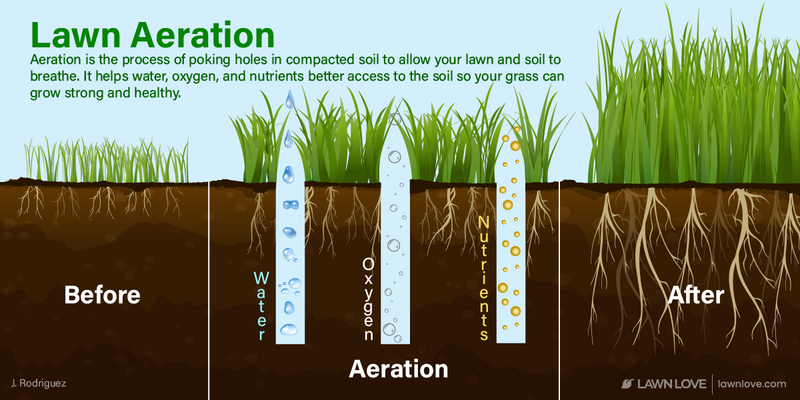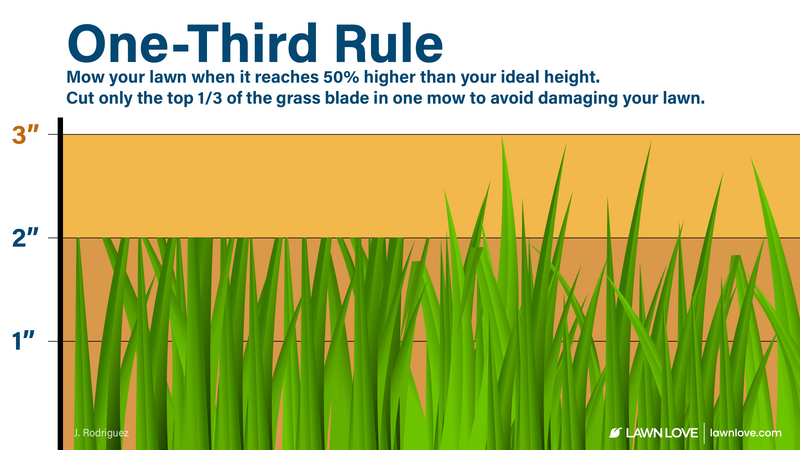
With the days growing longer and the temperatures rising, springtime in Dayton is a warm welcome after months of shoveling snow and hibernating from the cold. Now it’s time to get outdoors and do some spring lawn care to get your yard looking great again.
1. Clean up yard debris
Sure, a blanket of snow may be beautiful, but once it begins to melt, the unsightly debris and dead grass left behind can cause major damage to your lawn. Due to the lack of air circulating and trapped moisture, fungal diseases such as snow mold can attack, having the potential to kill your grass.
Use a rake to remove debris, excess thatch, and dead grass after the snow melts. Along with removing dead leaves and grass, remove any fallen limbs or branches, and clear the yard of any other remaining debris. Before you follow any of the other steps on our list, it’s important to start with a clean canvas for your grass to grow and thrive.
2. Control weeds
The main way to control weeds is by focusing on proper lawn care practices such as regular mowing, adequate watering, and reseeding thin areas. The thicker and healthier your lawn, the stronger it is to fight against weeds. But in spring, you might see some weeds popping up.
In early spring, apply pre-emergent herbicides. This type of herbicide provides a protective barrier around seeds, preventing them from germinating and growing. However, if spring weeds are already sprouting, apply a post-emergent herbicide. This type of herbicide is effective at killing weeds by attacking the root system.
Listed below are some common weeds found in Dayton lawns and how to treat them:
Dandelions
- Dandelions can impact your lawn’s development by establishing deep roots and competing for space and nutrients.
- The most effective way to remove dandelions is to hand pull. Just be sure to remove the entire taproot or else it will resurface.
White clover
- This perennial has a shallow root system. White clover’s spiky white flowers can spread extremely fast if not managed properly. Because they spread so fast, they can easily crowd out desired turfgrass.
- White clover can be treated by hand-pulling both the flower and roots. Organic herbicides are also effective at killing clover, while not harming the surrounding grass.
Wild violet
- Extremely difficult to manage due to its extensive root system, aggressive growing pattern, and waxy leaves.
- Best to repeatedly treat wild violet with a broadleaf herbicide throughout the year. Use an herbicide that contains 2,4-D, or Dicamba to selectively kill the wild violets without damaging the surrounding grass.
Corn speedwell (Veronica)
- Defined by a four-petaled blue or white flower combined with a heart-shaped seed pod, Veronica is incredibly invasive and difficult to control. It has a thick, green, weedy bottom and fibrous root system.
- Having thick, healthy turf is the best method to prevent corn speedwell in your lawn. Corn speedwell can be spot-treated with a 2,4-D-based weedkiller in spring or early summer, when its growth is at its most active. Repeat through summer as necessary.
For a comprehensive guide to weed control, check out Ohio State University’s Weed Control Guide.
3. Treat lawn diseases
After the long, cold winter, diseases can attack your grass. There are many factors that can lead to lawn disease: pathogens such as fungus, bacteria or a virus; wet grass; hot, humid conditions; improper fertilization; weeds; compacted soil; nutrient-deficient soil; and mowing your grass too short.
Here in Dayton, there are 12 common lawn diseases:
- Brown patch
- Dollar spot
- Fairy ring
- Lawn rust
- Leaf spot
- Snow mold
- Pythium blight
- Red thread
- Slime mold
- Powdery mildew
- Gray leaf spot
- Summer patch
The best defense against any disease is healthy lawn care practices. But if you do identify one of the diseases attacking your lawn, you will have to resort to organic or inorganic fungicide treatments. Find out more on the best method to combat each of these common lawn diseases.
4. Get rid of pests
Dayton is home to several common lawn pests. Although they are extremely small, each one of these pests can cause significant damage to your grass if left untreated.
Billbugs
What they look like: Referred to as “snout beetles,” these destructive nuisances are gray or black in color, while the larvae are either white or cream with reddish-brown heads.
How they damage the lawn: They destroy the turf crowns, and during extreme periods of drought, this will kill the entire grass plant.
How to treat them: Choose resistant turfgrasses, such as ryegrasses and turf-type tall fescues. You also can apply fungicides, parasitic nematodes, and chemical treatments.
Chinch bugs
What they look like: Chinch bugs have oval-shaped bodies with two overlapping wings featuring a black triangle shape. Juveniles are bright orange.
How they damage the lawn: Initial chinch bug damage can be detected if you notice irregular patches of your turf starting to turn yellow then brown. These patches will continue to extend outward and will eventually cause the turfgrass to die.
How to treat them: Four practices are known to help combat chinch bugs. These include using resistant turfgrasses, regular watering, fertilizer applications, and fungal applications.
White grubs
What they look like: White grubs are easily identified by their whitish, “C”-shaped bodies that are about 1/2 an inch long. They are slick and slimy with brown heads and a dark area toward their posterior.
How they damage the lawn: White grubs damage turf by chewing the grass roots just below the soil’s surface. This reduces the turf’s ability to absorb nutrients and water needed to survive periods of hot, dry weather.
How to treat them: Remove excess thatch. They complete their development feeding on nothing but thatch.
5. Test your soil
Just like a doctor diagnoses your condition before they write you a prescription, it’s critical to have your soil checked before applying fertilizer. A soil test will tell you the health and fertility of your soil. It measures key nutrients such as nitrogen, phosphorus, and potassium, along with magnesium, calcium, hydrogen, and sodium.
You can visit Ohio State University Extension’s website for more information on how to purchase a kit, extract a proper sample, and submit it for testing.
6. Fertilize for healthy growth
Now that you have your soil test results, you should know what type of fertilizer your lawn needs based on what nutrients it may be lacking.
For optimal grass growth, you should fertilize three times a year. Both cool-season and warm-season grasses benefit from a feeding in late spring.
Once you know which fertilizer to use, follow the fertilization schedule in the chart below, depending on your grass type.
Cool-season (fescues, Kentucky bluegrass, perennial ryegrass):
- First feeding – April
- Second feeding – September
- Third feeding – November
Warm-season (buffalograss):
- First feeding – April
- Second feeding – June
- Third feeding – September
7. Aerate

Aerating your lawn relieves soil compaction and controls thatch. It opens up the soil to allow water, air, and nutrients to reach grass roots.
Spring and fall are the best times to aerate your Dayton lawn since that is when cool-season grasses (the most popular choice for Ohio lawns) can handle the stress of aeration.
There are two aeration methods:
- Core aeration: Uses a machine with hollow tines that mechanically extracts cores or plugs of soil
- Spike aeration: Alleviates compaction by piercing the soil without actually removing it from the ground
Either method can be performed by lawn care professionals, or you can rent an aerator from most home improvement stores.
8. Mow for the first time
Don’t start to mow until your grass starts to grow. Start by mowing at a lower cutting height (2 inches) to get rid of dead grass blades and expose sunlight to the crown to encourage faster green-up. Just be sure to avoid scalping.
Listed below are some practices to follow when mowing your lawn:
- Keep your lawn mower blades sharp and balanced.
- Follow the “One-Third Rule” to ensure you don’t scalp your lawn. This means never removing more than one-third of your grass height at each mow.
- Alternate your mowing patterns to encourage optimal growth.
- Leave mulched grass clippings on the lawn to add organic matter and nitrogen.

Check out this chart that lists Dayton’s most common grass types and the recommended mowing height.
| Grass Type | Recommended Mowing Height |
| Buffalograss | 2.5-3.5 inches |
| Kentucky bluegrass | 2.5-3 inches |
| Tall Fescue | 3-4 inches |
| Perennial ryegrass | 1.5-2.5 inches |
| Fine fescue | 3-4 inches |
Maintain your beautiful Dayton lawn
Now that the snow is finally gone and longer, warmer days are here, it’s the perfect time to prepare your lawn for the busy summer mowing season.
But if you’d rather enjoy the beautiful outdoors kayaking in Eastwood Lake or enjoying a local craft beer at The Dayton Beer Company, then let the professionals at Lawn Love get our grass back into shape.
Main Photo Credit: Maksim Goncharenok | Pexels